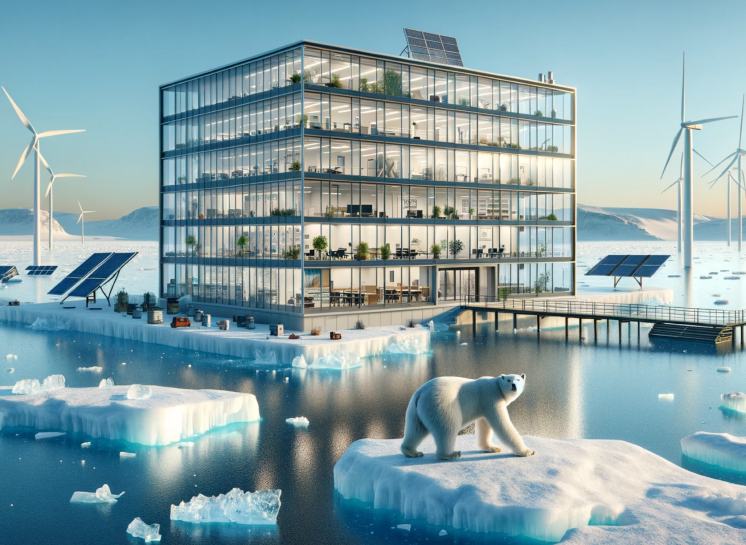2025 Beaufort Delta Career Fair: Building the Workforce the North Needs
November 5th, 2025
Inuvik, NT


20 May 2024

As global travelers seek out unique and unspoiled destinations, the Arctic has emerged as a captivating frontier for adventure and cultural tourism. This article delves into the burgeoning Arctic tourism industry, highlighting the opportunities and challenges of promoting the Arctic as a travel destination. Through interviews with tour operators, tourists, and local stakeholders, we explore the region's potential to become a premier spot on the global travel map.
The Arctic offers unparalleled natural beauty, from majestic fjords and vast ice fields to the mesmerizing Northern Lights. Coupled with rich Indigenous cultures and unique wildlife, the region provides a diverse array of experiences for intrepid travelers.
Victoria Brown, a seasoned traveler who recently explored the Canadian Arctic, describes her experience: "The Arctic is unlike any place I've ever visited. The pristine landscapes and the chance to learn about Indigenous cultures made it a truly transformative journey."
The potential for Arctic tourism is vast, driven by increasing interest in adventure travel and ecotourism. Several factors contribute to this growing interest:
Jake Taylor, owner of Arctic Adventure Tours, highlights the unique opportunities: "Our guests come for the adventure but leave with a deep appreciation for the land and its people. The Arctic offers something genuinely unique, and that’s a powerful draw."
Despite its potential, the Arctic tourism industry faces significant challenges:
Alice Mackenzie, a local stakeholder from Inuvik, Northwest Territories, discusses these challenges: "Building the necessary infrastructure while protecting our environment is a delicate balance. We want to share our home with the world, but it has to be done responsibly."
To harness the potential of Arctic tourism while addressing its challenges, stakeholders are adopting several strategies:
1. Sustainable Tourism Practices
Implementing sustainable tourism practices is crucial for protecting the Arctic environment. This includes minimizing waste, using renewable energy sources, and promoting eco-friendly transportation options.
2. Community Involvement
Engaging local communities in tourism development ensures that the benefits of tourism are shared. Indigenous-led tours and cultural experiences not only provide authentic insights for visitors but also create economic opportunities for local residents.
Sophie Arnaktauyok, an Indigenous tour operator from Nunavut, emphasizes community involvement: "Tourism provides a platform for us to share our stories and traditions. It’s important that our communities are actively involved in shaping how tourism develops here."
3. Investment in Infrastructure
Strategic investments in infrastructure, such as improving airports, roads, and accommodation facilities, are necessary to support the growing number of tourists. Public-private partnerships can play a key role in financing these developments.
4. Marketing and Promotion
Effective marketing and promotion are essential for raising awareness about the Arctic as a travel destination. Leveraging digital marketing, social media, and partnerships with travel influencers can help attract a global audience.
5. Training and Education
Providing training and education for local residents ensures that they have the skills needed to thrive in the tourism industry. Programs focusing on hospitality, tour guiding, and business management can empower local communities to take full advantage of tourism opportunities.
1. Churchill, Manitoba
Churchill, known as the "Polar Bear Capital of the World," has successfully leveraged its unique wildlife to attract tourists. Through strategic marketing and sustainable tourism practices, Churchill has become a leading destination for wildlife enthusiasts.
2. Ilulissat, Greenland
Ilulissat, a town in western Greenland, has gained international recognition for its stunning ice fjord, a UNESCO World Heritage site. Investment in infrastructure and community-driven tourism initiatives have made Ilulissat a model for sustainable Arctic tourism.
The future of Arctic tourism looks promising, with increasing interest from travelers seeking unique, sustainable experiences. However, realizing this potential requires a concerted effort from all stakeholders to address the challenges and implement strategies that ensure the region's long-term sustainability.
Peter Nilsson, a tourism consultant specializing in Arctic destinations, concludes: "The Arctic holds immense appeal for the modern traveler, but it’s vital that growth is managed carefully. With the right approach, Arctic tourism can flourish, providing economic benefits while preserving the region’s natural and cultural heritage."
As the Arctic opens up to the world, it offers not just a travel destination but a chance for visitors to connect with a unique part of our planet. By embracing sustainable practices and community involvement, the Arctic tourism industry can thrive, offering unforgettable experiences that leave a lasting impact on both travelers and the region itself.


Feature stories on Indigenous businesses that are successfully integrating traditional practices with modern business models, preserving cultural heritage while driving economic growth.
20 May 2024
Interviews with women leaders in the Arctic business community, exploring their contributions, the unique challenges they face, and their visions for the future.
20 May 2024
Arctic Business is brought to you by the Western Arctic Business Association (WABA), which supports business growth in the Western Arctic. WABA connects local businesses, governments, and stakeholders to promote economic development, providing resources and advocacy to help members thrive in this unique region.